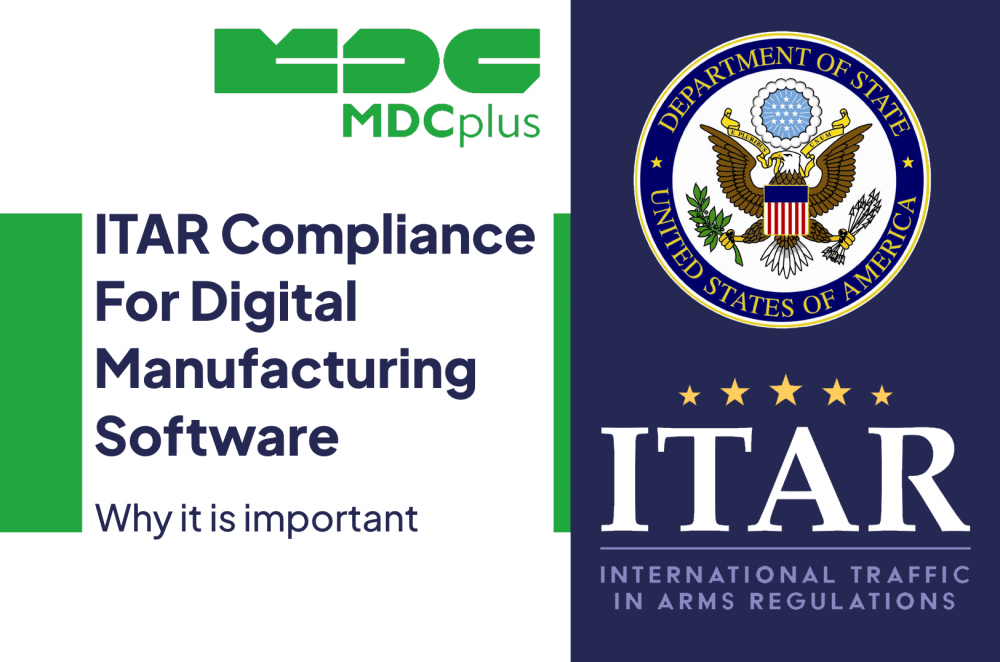Looking for reliable monitoring?
Get started with MDCplusWhy ITAR Compliance Matters for Digital Manufacturing Software
What Is ITAR?
The International Traffic in Arms Regulations (ITAR) is a U.S. government mandate that controls the export and handling of defense-related articles and services listed on the United States Munitions List (USML). While it initially focused on physical goods, the scope of ITAR has evolved to cover technical data and digital systems as well—particularly when those systems are used in the production or support of defense items.
Why ITAR Applies to Digital Software
Digital manufacturing software—especially platforms that handle real-time machine data, operator logs, NC files, quality reports, and part serials—can fall under ITAR regulations if used in defense-related programs. This includes software that:
-
Collects or stores production data for defense parts
-
Is installed on machines used to manufacture ITAR-controlled items
-
Facilitates collaboration or file-sharing involving technical data
-
Supports planning or execution of defense contracts
Even if your software doesn’t directly control machines, it can still be classified as an ITAR-sensitive tool if it processes or stores technical data that’s tied to U.S. defense programs.
What Counts as “Technical Data” Under ITAR?
ITAR defines "technical data" broadly. It includes:
- Blueprints and CAD models
- NC programs (like G-code)
- Manufacturing process documentation
- Operator or machine logs if they reference defense production
- Communication or collaboration platforms where technical data is exchanged
If your software stores or processes any of this information—and especially if that data is accessible outside the U.S.—you’re operating in ITAR territory.
The Risks of Non-Compliance
Failure to comply with ITAR can lead to serious consequences, including:
- Hefty fines (up to $1 million per violation)
- Criminal charges in extreme cases
- Bans from working on future defense contracts
- Reputational damage with clients and partners
For digital platforms, the biggest compliance gaps often involve data storage and access. Cloud-based software, global support teams, and distributed development pipelines can all trigger ITAR violations if not properly managed.
Key ITAR Compliance Requirements for Digital Tools
If your system is or could be used in ITAR-regulated environments, here’s what you need to consider:
-
U.S.-Only Data Hosting
Data related to defense manufacturing must be stored in physically located U.S. data centers unless a specific license is obtained. -
Controlled Access
Only U.S. persons (citizens or permanent residents) should have access to ITAR-regulated data. This applies to developers, support engineers, and cloud administrators. -
End-to-End Encryption
All transmissions of technical data must be encrypted, especially if your system supports remote access, file sharing, or mobile use. -
Audit Trails and Logging
You must be able to demonstrate who accessed what data and when—this is essential for both internal governance and external audits. -
Controlled Collaboration
If your platform allows collaboration or file sharing, ensure it includes role-based access control and audit mechanisms. -
Training and Awareness
Your team (especially support, QA, and sales engineers) needs to understand what ITAR is and how it affects their work.
ITAR As Competitive Advantage
While ITAR compliance can feel like a heavy lift, it’s also an opportunity. For digital tool providers, demonstrating compliance:
- Opens the door to U.S. defense and aerospace clients
- Builds trust with global OEMs who serve U.S. defense programs
- Future-proofs your platform against regulatory risks
Digital manufacturing tools are no longer exempt from export regulations. If your software is being used—or might be used—in defense-related manufacturing, ITAR is not optional. It’s an essential part of doing business, and the sooner it’s built into your infrastructure, the safer and more competitive your company will be.
About MDCplus
Our key features are real-time machine monitoring for swift issue resolution, power consumption tracking to promote sustainability, computerized maintenance management to reduce downtime, and vibration diagnostics for predictive maintenance. MDCplus's solutions are tailored for diverse industries, including aerospace, automotive, precision machining, and heavy industry. By delivering actionable insights and fostering seamless integration, we empower manufacturers to boost Overall Equipment Effectiveness (OEE), reduce operational costs, and achieve sustainable growth along with future planning.
Ready to increase your OEE, get clearer vision of your shop floor, and predict sustainably?
